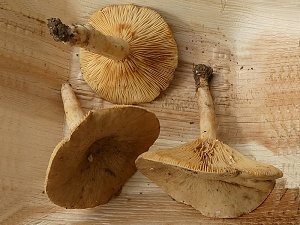| Lactarius pterosporus Romagn. |
|
|
|
|
|
|
The cap is grey-brown to ochre coffee-brown, convex-flattened, then depressed to funnel-shaped, with or without an umbo; its margin is smooth, thin. The cap surface is very radially wrinkled at its centre, dry, matt. The stem is cream to pale ochre, reddening when manipulated, without ring. The flesh is whitish, turning to pink when exposed to air in about 2-3 mns; its taste is almost mild (flesh) to slightly hot (milk); the odour is faint, unpleasant or of coconut; its texture is grainy (breaking like a chalk stick), exuding a white milk when cut, unchanging when isolated, but drying reddish. The gills are cream to yellow orange or salmon, reddish in bruises, adnate to decurrent, crowded . The spore print is ochre-cream. This species is mycorrhizal. It grows on the ground, in deciduous woods, on a rather clayey-calcareous and rich soil, with hornbeam, oak and beech. The fruiting period takes place from July to November.
Distinctive features : downy cap, distinctly wrinkled, uniformly ochre-brown to fawn, reddish in bruises; pied beige; white milk, almost unchanging on cloth; flesh turning pink when exposed in 2-3mns; mild taste, then peppery and slightly hot; with broad-leaved trees Lactarius pterosporus is still unreported so far in the forest of Rambouillet, and is occasional, more generally speaking .
page updated on 14/01/18 |
